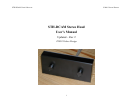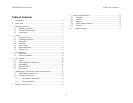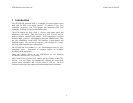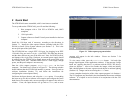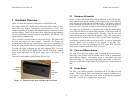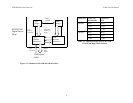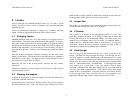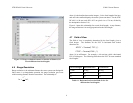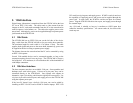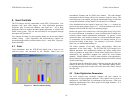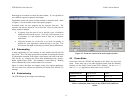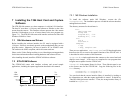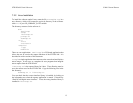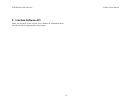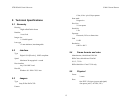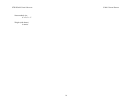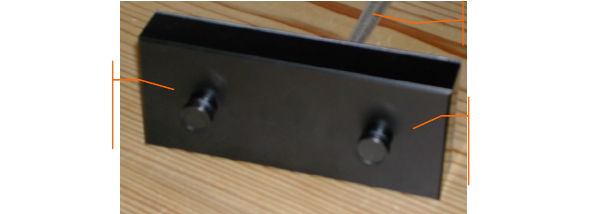
STH-DCAM USER’S MANUAL 2001 VIDERE DESIGN
3 Hardware Overview
Figure 3-1 shows the hardware configuration of the STH-DCAM.
The imager module has a milled Delrin frame that rigidly holds two Sony
HAD CCD color imagers, separated by a fixed distance of 9 cm. Lens
mounts are attached to the frame, and standard miniature lenses are screwed
into these holders. There is an IR curoff filter, with a knee at approximately
700 nm, permanently mounted inside the lens holder. See Section 4 for
appropriate lens characteristics.
There is a IEEE 1394 port on the left side of the device. The cable carries
the data and signals for both imagers. Internally, the imagers are
synchronized so that they are exposed at the same time, a requirement for
stereo processing whenever there is any motion (including camera motion).
Typically, the cable is plugged into the host computer IEEE 1394 card.
Power for the STH-DCAM is supplied from the card, or through a separate
power supply that plugs into the power supply port of the device (7-40
VDC).
There are no user-settable switches on the STH-DCAM.
3.1 Hardware Schematic
Figure 3-2 shows the design of the internal hardware of the STH-DCAM.
In the stereo imager module, two Sony CCD imagers, each of size 648x486
pixels, digitize incoming light into a digital stream. A full frame is captured
at once, and then read out line by line. The imagers operate in progressive
mode only, that is, each line is output in succession from the full frame.
The imagers are synchronized to a common clock, so that the corresponding
pixels from each imager are output at the same time. Each imager sends out
its own video stream, on a separate IEEE 1394 cable. There are two such
cables coming out of the STH-DCAM module. Each video stream has a
maximum rate of 200 Mbps; the whole IEEE 1394 bus runs at 400 Mbps.
Each imager is supplied with power from its cable. In order to synchronize
correctly, power must be applied to the imagers at the same time.
Typically, the two cables are connected to a small 3-port IEEE 1394 hub,
which is then connected to the host IEEE 1394 port.
3.2 Color and Monochrome
The Sony CCDs are color imagers, with a standard Bayer color pattern.
Processing in the STH-DCAM can produce either a color or monochrome
output from the imagers. Monochrome output is 1 byte/pixel, and color
outputs are either 2 or 3 bytes/pixel, depending on the format. If color isn’t
necessary, monochrome output should be selected, to save on movement of
data.
Figure 3-1. Physical layout of the STH-DCAM stereo head.
1394 cables
Right
miniature
lens
3.3 Frame Rates
Left
miniature
lens
The IEEE 1394 interface supports a maximum rate of 200 Mbps on each
imager. The maximum frame rates depend on whether monochrome or
color output is used. Frame rates up to 30 Hz at 640x480 are supported.
See Table 3-1 below for a complete list of frame rates.
5



